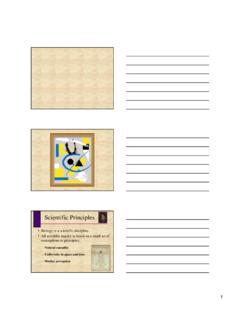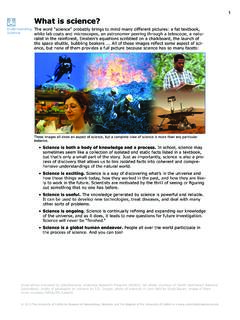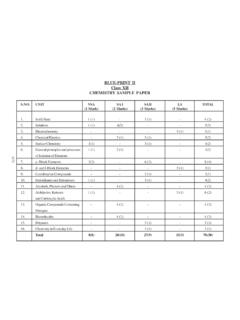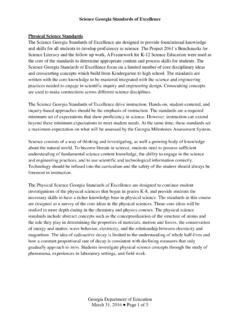Transcription of THE USE OF REACTIVE SILANE CHEMISTRIES TO …
1 THE USE OF REACTIVE SILANE CHEMISTRIES TO provide durable , NON- leaching antimicrobial surfaces Robert A. Monticello, PhD, GIS Environments Midland, Michigan, 48640 Tel: +1 989 832 8180 Fax: +1 989 832 7572 email: BIOGRAPHICAL NOTE Robert A. Monticello received a in Microbiology from Michigan State University and a in Molecular Biology from Western Michigan University. He obtained his in Biochemistry and Molecular Medicine at the Wayne State University Medical School in Detroit, Michigan and completed a Post-Doctoral Fellowship at the Wayne State University Department of Molecular Medicine in Human Gene Therapy.
2 After his formal educational training, he joined AEGIS Environments, a global manufacturer and supplier of antimicrobial agents, where he is currently a Vice President and is the Chief Technical Officer for the company. ABSTRACT The application of a SILANE quaternary amine (Si-quat) based antimicrobial has been proven effective as a finishing agent on textiles and construction products for almost 40 years. antimicrobial agents of this type have been used on a wide variety of porous and non-porous systems with outstanding results. Successful applications can be achieved using almost any type of wet process, such as a pad or spray and but may also be extruded or molded into various synthetic materials.
3 Once the material is cured onto or into the substrate it can then provide the antimicrobial protection necessary to safeguard the product from microbial contamination and subsequent breakdown. This paper and presentation will cover not only the ease of use of the Si-Quat antimicrobials but will provide a review of the key data and test techniques relating to the demonstration of efficacy, durability and utility in dealing with microbial problems on non-porous surfaces under real-world in-use conditions. Durability and real-life performance are critical factors when choosing the proper antimicrobial treatment.
4 This eco-friendly product falls in line with the current emphasis on sustainability and environmental impact that is dominating the world markets. INTRODUCTION Almost all materials have one thing in common; they face a common enemy. Bacteria, fungi, algae, and other organisms can consume and degrade surfaces during shipment, storage, and use, causing loss of product as well as exposing the manufacturer to potential liability. Contamination and colonization of microorganisms on surfaces can result in problems as small as an offensive odor to serious human infections and death.
5 Imparting an antimicrobial agent into synthetic material can create microbial resistant, non-porous surfaces that can alleviate many of these problems. However, selecting the right antimicrobial is essential to provide the appropriate protection to the product as well as to protect our environment. The list of available agents becomes limited when the criteria selection includes durability, regulatory approvals (EU BPD, US EPA), spectrum of activity, and toxicity to both the manufacturer and the end-user. The use of a SILANE quaternary amine based antimicrobial can provide durable antimicrobial protection against a wide variety of microorganisms without the worry of leaching heavy metals, phenolic compounds or other toxic compounds that continue to contaminate our environment and present situations that promote microbial resistance.
6 Protection to the product as well as to protect our environment. The list of available agents becomes limited when the criteria selection includes durability, regulatory approvals (EU BPD, US EPA), spectrum of activity, and toxicity to both the manufacturer and the end-user. The use of a SILANE quaternary amine based antimicrobial can provide durable antimicrobial protection against a wide variety of microorganisms without the worry of leaching heavy metals, phenolic compounds or other toxic compounds that continue to contaminate our environment and present situations that promote microbial resistance.
7 Altering surfaces with durable non- leaching antimicrobial agents such that they provide an active killing "field" for killing one celled organisms on contact is a reasonable and attainable goal. The use of quaternized nitrogen silanes has been demonstrated to provide such treatments on a wide variety of surfaces and end-use conditions. There are many ways to modify surfaces so that they are less receptive to the settling, attachment, and colonization of microorganisms. These modifications can create surfaces so that microorganisms that come into direct contact with the treated surface are inhibited or killed or more easily cleaned away.
8 Chemical and physical bonding mechanisms using covalent bonding mechanisms, using covalent or ionic associations done by simple condensation reactions, energy induced as in plasma deposition, or catalyzed reactions of REACTIVE materials have been demonstrated. The success of these surface modifications at controlling the deposition, attachment and propagation of good (useful) or bad (destructive, interfering, or annoying) microorganisms has often been limited by many factors. These factors include the lack of durability of the coating and the practical and cost effective application of these agents during product manufacturing.
9 Such is the challenge to find technologies that can be evaluated and utilized in a safe, long lasting, and cost effective manner. SILANE quat monomeric agents can both self crosslink and can link with available surface sites to create fully cured polymer that binds directly to the surface providing an antimicrobial coating that becomes part of the substrate itself. The non- leaching behavior of such a REACTIVE surface allows for the control of surface microbial contamination without the continuous release of toxic components into the environment which can promote the formation of resistant organisms.
10 MICROORGANISMS Mold, mildew, fungus, yeast, bacteria, and virus (microorganisms), are part of our everyday lives. There are both good and bad types of microorganisms. The thousands of species of microorganisms that exist are found everywhere in the environment, on our garments, on our bodies and on virtually every surface around us. Microorganisms, their body parts, metabolic products, and reproductive parts, cause multiple problems to synthetic materials. They are human irritants, sensitizers, toxic -response agents, causers of disease, and simple discomforting agents.







